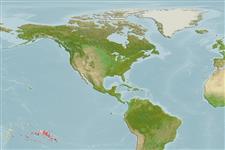Classification / Names
आम नाम | उपशब्द | Catalog of Fishes(वर्ग, प्रजाति) | ITIS | CoL | WoRMS | Cloffa
>
Perciformes/Serranoidei (Groupers) >
Grammistidae (Soapfishes)
Etymology: Pseudogramma: Greek, pseudes = false + Greek, gramma = letter, signal (Ref. 45335); paucilepis: Name from Latin 'paucus' meaning few, and the feminine Greek noun 'lepis' meaning scale; noun in apposition..
Environment: milieu / climate zone / depth range / distribution range
पारिस्थितिकी
समुद्री प्रवाल-भित्ति संयुक्त; गहराई सीमा 15 - 29 m (Ref. 116906). Subtropical
South Pacific: Gambier Archipelago and Austral Is.
आकार / वज़न / Age
Maturity: Lm ? range ? - ? cm
Max length : 6.0 cm SL पुल्लिंग / अलिंग; (Ref. 116906)
Short description
आकृति विज्ञान | मौरफोमैटरिक्स
पृष्ठीय रीढ़ (सम्पूर्ण): 7; पृष्ठीय सौफट रेज़ (सम्पूर्ण): 20; गुदा कांटा 3; ऐनल सौफट रेज़: 16 - 17; जानवरों की रीड़ का जोड़: 2 - 26. This species is distinguished by the following characters: dorsal fin with 20 segmented rays; anal fin with modally 16 segmented; relatively long lateral line, 1.8-2.3 (mean= 2.0) in SL; a relatively reduced scalation on interorbital, suborbital and dentary; HL 2.3-2.4 in SL, peduncle depth 4.2-5.0 in HL (Ref. 116906).
A cryptic species found in outer reef slopes (Ref. 116906).
Life cycle and mating behavior
परिपक्व अवधि | पुनरुत्पत्ति | मछलीऔ का अंडे देना | अंडे | Fecundity | लार्वा
Williams, J.T. and J. Viviani, 2016. <>iPseudogramma polyacantha complex (Serranidae, tribe Grammistini): DNA barcoding results lead to the discovery of three cryptic species, including two new species from French Polynesia. Zootaxa 4111(3):246-260. (Ref. 116906)
IUCN Red List Status (Ref. 130435)
Threat to humans
Harmless
Human uses
अधिक जानकारी
आम नामउपशब्दचपायचयपरभक्षीईकोटोकसीकोलौजीपुनरुत्पत्तिपरिपक्व अवधिमछलीऔ का अंडे देनाSpawning aggregationFecundityअंडेEgg development
Age/Sizeबाढ़Length-weightLength-lengthLength-frequenciesमौरफोमैटरिक्सआकृति विज्ञानलार्वालारवल गतिकीभर्तीबहुतायतBRUVS
संदर्भजलीयकृषिजलीयकृषि रूपरेखाखींचआनुवंशिकीElectrophoresesहैरेटिबिलटीबीमारीप्रक्रमणNutrientsMass conversion
सहयोगीयोतस्वीरेStamps, Coins Misc.ध्वनिसिगुयटिरारफ्तारतैरने के प्रकारगिल क्षेत्रOtolithsदिमागदृष्टि
साधन
Special reports
Download XML
इंटरनेट स्रोत
Estimates based on models
Phylogenetic diversity index (Ref.
82804): PD
50 = 0.5001 [Uniqueness, from 0.5 = low to 2.0 = high].
Bayesian length-weight: a=0.01148 (0.00451 - 0.02922), b=3.06 (2.84 - 3.28), in cm total length, based on LWR estimates for this (Sub)family-body shape (Ref.
93245).
Trophic level (Ref.
69278): 3.6 ±0.5 se; based on size and trophs of closest relatives
Fishing Vulnerability (Ref.
59153): Low vulnerability (10 of 100).
